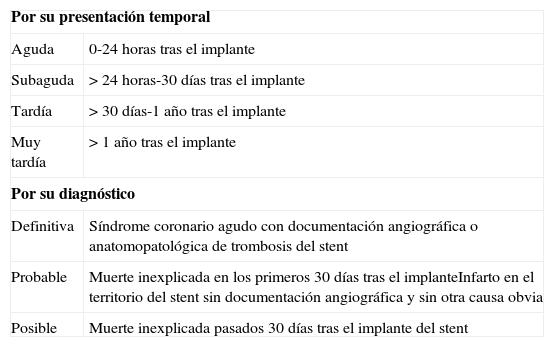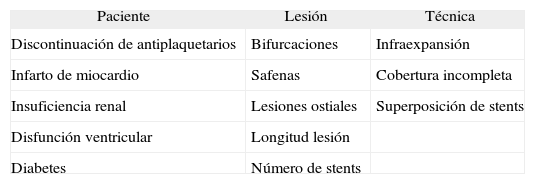La trombosis del stent (TS) es una complicación infrecuente pero potencialmente letal de las endoprótesis coronarias. Los ensayos clínicos no han demostrado diferencias en la incidencia de trombosis temprana y tardía entre stents convencionales (SC) y stents liberadores de fármacos antiproliferativos (SLF). La trombosis muy tardía ocurre pasado un año de la implantación del stent y es más específica de los SLF.
En la etiopatogenia de la trombosis del stent intervienen factores relacionados con el paciente, el stent, la lesión y la técnica de implante. El principal factor de riesgo para la TS es la suspension prematura de los fármacos antiplaquetarios.Actualmente los pacientes deben recibir ácido acetilsalicílico y una tienopiridina por lo menos durante un mes tras el implante de un SC y durante 12 meses tras el implante de un SLF, manteniendo posteriormente un antiplaquetario de forma indefinida.
Stent thrombosis (ST) is an uncommon but potentially lethal complication of coronary endoprothesis. Clinical trials have not shown differences in the incidence of early and late thrombosis among bare-metal stents and drugeluting stents. Very late stent thrombosis occurs more than a year after stent implantation and is more specific of drug-eluting stents.
Factors related to the patient, the stent, the coronary lesion and the technique are involved in the pathogenesis of ST. The main risk factor ST is the premature discontinuation of antiplatelet therapy. Currently, patients must receive aspirin and a thienopyridine for at least one month after the implantation of a bare-metal stent and 12 months after the implantation of a drug-eluting stent, then maintaining one antiplatelet agent indefinitely
Article
Diríjase desde aquí a la web de la >>>FESEMI<<< e inicie sesión mediante el formulario que se encuentra en la barra superior, pulsando sobre el candado.

Una vez autentificado, en la misma web de FESEMI, en el menú superior, elija la opción deseada.

>>>FESEMI<<<







